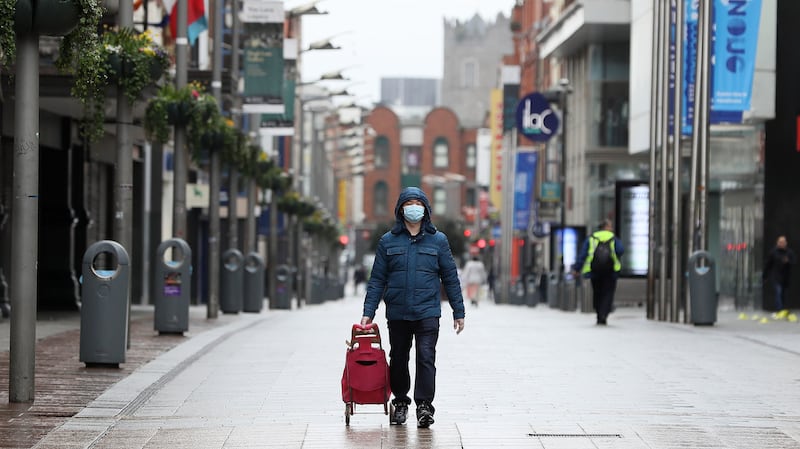The Government is aiming to curb the spread of coronavirus to such an extent that this will allow it to ease restrictions on a trial basis.
However, it also plans to be able to reintroduce strict measures quickly, before new infections increase substantially, if the virus shows signs of spreading again.
The existing period of lockdown, extended last week, will apply until after the May bank holiday weekend, and senior Government figures stress that while they do not want to extend it further, they will do so if necessary.
While “very preliminary work” is being carried out by health officials on how to “ease the restrictions”, according to a senior Government source, the rate of reproduction of the virus must drop in the coming weeks, among other indicators.
A further 14 people have died of the coronavirus in Ireland and 727 new cases have been confirmed, the National Public Health Emergency Team (NPHET) said on Sunday. A total of 334 people have now died in the State after contracting Covid-19, and a total of 9,655 cases have been diagnosed since the pandemic began.

NPHET said 12 of the 14 deaths took place in the east of the country, with two in the west. The deceased were six women and eight men, with the median age of Sunday’s reported deaths being 80.
Ten of the 14 were reported as having underlying health conditions.
Meanwhile, in Northern Ireland 11 more people have died from coronavirus, bringing the total number of confirmed deaths there to 118. An additional 89 cases of coronavirus were confirmed on Sunday, taking the total number to 1,806.
It is hoped the current lockdown slows the virus to such an extent that will allow “space” for some restrictions to be eased – such as some pupils being allowed attend school on a limited basis – without risking a substantial rise in infections; if this happens, stricter measures will be reintroduced.
Test criteria
It is stressed that the period after the lockdown will see quicker testing done, with the criteria for a test broadening from those showing two symptoms of the virus to just one. Testing would be done with “as high a suspicion as possible”.
Minister for Health Simon Harris has said the growth rate of the virus, which is now just below 10 per cent, needs to fall to below 5 per cent; that the average number of people in intensive care units needs to drop to near 100 from its current level of about 150.
Mr Harris also said the reproductive rate of virus – the rate which measures how many people each infected person is likely to pass the virus on to – is now “in and around” one.
“If that is just above one, the virus continues to grow; if it is slightly below one, the virus is beginning to be suppressed,” he said.
A reproductive rate of 0.6 or 0.7 is said to offer the “space” to ease some restrictions and monitor the effect of such a move while allowing stricter measures to be brought in again if needed without risking a dramatic spike in new infections.
Easing of restrictions
While consideration of what restrictions to ease is at an early stage, the measures under consideration include limited school openings, such as allowing some children back in the classroom for restricted hours, although creches would remain closed.
Some retail outlets, such as DIY and garden stores, could also open and there may also be an easing on the requirement of those over 70 to cocoon. This could allow for exercise outside of the home at certain times. Smaller construction sites may also re-open although offices would remain closed for “many months more”, with working from home to remain in place “for the forseeable future”.
As of 1pm on Sunday, the Health Protection Survelliance Centre (HPSC) had been notified of an additional 430 new confirmed cases of Covid-19 reported by Irish laboratories and an additional 297 confirmed cases of Covid-19 reported by a laboratory in Germany.
The median age of confirmed cases is 48 years, with 1,777 cases (21 per cent) having been hospitalised. Of those hospitalised, 261 cases have been admitted to ICU. A total of 2,312 cases are associated with healthcare workers.

In an Easter message, Taoiseach Leo Varadkar said the country would face some of its darkest days in the weeks ahead as a result of the pandemic.
Mr Varadkar said the country was preparing to reach its Covid-19 peak later this month.
“The number of hospitalisations and sadly the number of deaths continues to rise,” he said.
“So we cannot lose focus. We cannot lessen our efforts. In fact, we need to redouble them for the next few weeks.
“It’s more important than ever that we persevere. It’s possible that we haven’t seen the peak yet.
“When it comes, perhaps later this month, we will experience some of our darkest days. So we need to maintain our discipline and resolve in the knowledge that better days are to come.”













